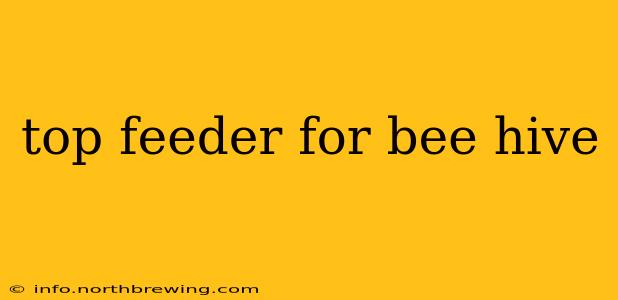Keeping your beehive thriving requires diligent attention to detail, and providing a reliable and efficient feeding system is crucial, especially during periods of nectar dearth or when establishing a new colony. A top feeder offers a convenient and less disruptive method of supplementing your bees' food supply compared to other feeding methods. This guide explores the various types of top feeders available, their pros and cons, and how to choose the best one for your beekeeping needs.
What are the Different Types of Top Beehive Feeders?
Several top feeder designs cater to different beekeeping preferences and hive configurations. The most common types include:
-
Entrance Feeders: While not technically a top feeder, these are worth mentioning as an alternative. Entrance feeders are placed at the hive entrance and are generally less preferred as they are more susceptible to robbing and can attract unwanted pests.
-
Frame Feeders: These are designed to fit inside the hive body, often replacing a frame. They’re relatively easy to use and generally less prone to robbing than external feeders. However, they take up valuable space in the hive.
-
Internal Top Feeders: These sit inside the hive, often on top of the frames, under the inner cover. They minimize the risk of robbing and are easy to access.
-
External Top Feeders: These sit on top of the inner cover, providing easy access without disturbing the bees significantly. However, they are more exposed to the elements and might be more prone to robbing if not managed correctly.
How Do I Choose the Right Top Feeder for My Hive?
Selecting the ideal top feeder depends on several factors:
- Hive type: Ensure the feeder is compatible with your hive configuration (Langstroth, Warre, etc.).
- Colony size: Larger colonies might need larger feeders.
- Climate: External feeders might be unsuitable in harsh weather conditions.
- Ease of use: Consider how easy it is to fill and clean the feeder.
- Robbing prevention: Choose a design that minimizes the risk of robbing.
What are the Advantages of Using a Top Feeder?
Top feeders offer several key advantages:
- Reduced robbing: Compared to entrance feeders, top feeders significantly decrease the risk of robbing by other bees or pests.
- Easy access: They allow you to feed your bees without disturbing the hive significantly.
- Cleanliness: Many top feeders are designed for easy cleaning and maintenance.
- Less disruption to the colony: Bees can access the feed without having to navigate through the entrance.
What are the Disadvantages of Using a Top Feeder?
While offering significant benefits, top feeders also have some drawbacks:
- Potential for drowning: Improperly designed feeders can lead to bees drowning in the syrup.
- Space constraints: Some internal top feeders can reduce the available space in the hive body.
- Cost: Some top feeders can be more expensive than other feeding methods.
What is the Best Way to Prevent Drowning in a Top Feeder?
Drowning is a major concern with top feeders. To prevent it:
- Use floaters: Many top feeders include floaters or devices that keep the syrup from submerging the bees.
- Use a less viscous syrup: A thinner syrup is less likely to cause drowning.
- Regularly check the feeder: Ensure the syrup level is appropriate and that bees aren't drowning.
- Choose a well-designed feeder: A quality feeder with proper ventilation and a suitable design can reduce the risk of drowning.
How Often Should I Check My Top Beehive Feeder?
The frequency of checking your top feeder depends on several factors, including the size of your colony, the weather conditions, and the amount of syrup you’ve provided. Generally, it’s a good practice to check your feeder at least once a week to ensure there's enough syrup and that no bees have drowned. During periods of rapid consumption or harsh weather, you may need to check more frequently.
By carefully selecting and maintaining a suitable top feeder, you can ensure your bees receive the nourishment they need to thrive, contributing to a healthy and productive hive. Remember to always prioritize bee safety and adopt responsible beekeeping practices.
